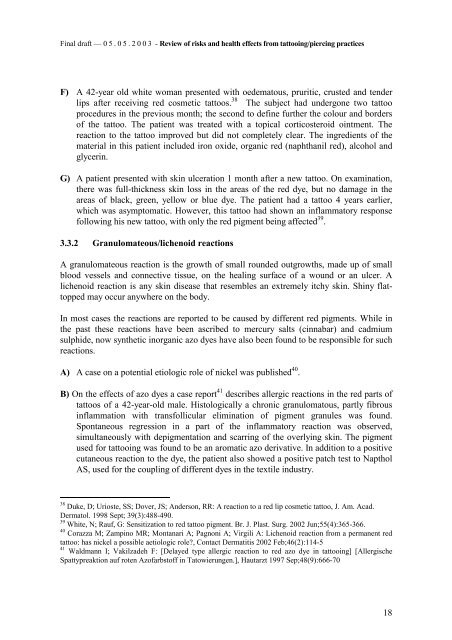Risks and Health Effects from Tattoos, Body Piercing and Related ...
Risks and Health Effects from Tattoos, Body Piercing and Related ...
Risks and Health Effects from Tattoos, Body Piercing and Related ...
Create successful ePaper yourself
Turn your PDF publications into a flip-book with our unique Google optimized e-Paper software.
Final draft –– 05.05.2003 - Review of risks <strong>and</strong> health effects <strong>from</strong> tattooing/piercing practices<br />
F) A 42-year old white woman presented with oedematous, pruritic, crusted <strong>and</strong> tender<br />
lips after receiving red cosmetic tattoos. 38 The subject had undergone two tattoo<br />
procedures in the previous month; the second to define further the colour <strong>and</strong> borders<br />
of the tattoo. The patient was treated with a topical corticosteroid ointment. The<br />
reaction to the tattoo improved but did not completely clear. The ingredients of the<br />
material in this patient included iron oxide, organic red (naphthanil red), alcohol <strong>and</strong><br />
glycerin.<br />
G) A patient presented with skin ulceration 1 month after a new tattoo. On examination,<br />
there was full-thickness skin loss in the areas of the red dye, but no damage in the<br />
areas of black, green, yellow or blue dye. The patient had a tattoo 4 years earlier,<br />
which was asymptomatic. However, this tattoo had shown an inflammatory response<br />
following his new tattoo, with only the red pigment being affected 39 .<br />
3.3.2 Granulomateous/lichenoid reactions<br />
A granulomateous reaction is the growth of small rounded outgrowths, made up of small<br />
blood vessels <strong>and</strong> connective tissue, on the healing surface of a wound or an ulcer. A<br />
lichenoid reaction is any skin disease that resembles an extremely itchy skin. Shiny flattopped<br />
may occur anywhere on the body.<br />
In most cases the reactions are reported to be caused by different red pigments. While in<br />
the past these reactions have been ascribed to mercury salts (cinnabar) <strong>and</strong> cadmium<br />
sulphide, now synthetic inorganic azo dyes have also been found to be responsible for such<br />
reactions.<br />
A) A case on a potential etiologic role of nickel was published 40 .<br />
B) On the effects of azo dyes a case report 41 describes allergic reactions in the red parts of<br />
tattoos of a 42-year-old male. Histologically a chronic granulomatous, partly fibrous<br />
inflammation with transfollicular elimination of pigment granules was found.<br />
Spontaneous regression in a part of the inflammatory reaction was observed,<br />
simultaneously with depigmentation <strong>and</strong> scarring of the overlying skin. The pigment<br />
used for tattooing was found to be an aromatic azo derivative. In addition to a positive<br />
cutaneous reaction to the dye, the patient also showed a positive patch test to Napthol<br />
AS, used for the coupling of different dyes in the textile industry.<br />
38<br />
Duke, D; Urioste, SS; Dover, JS; Anderson, RR: A reaction to a red lip cosmetic tattoo, J. Am. Acad.<br />
Dermatol. 1998 Sept; 39(3):488-490.<br />
39<br />
White, N; Rauf, G: Sensitization to red tattoo pigment. Br. J. Plast. Surg. 2002 Jun;55(4):365-366.<br />
40<br />
Corazza M; Zampino MR; Montanari A; Pagnoni A; Virgili A: Lichenoid reaction <strong>from</strong> a permanent red<br />
tattoo: has nickel a possible aetiologic role?, Contact Dermatitis 2002 Feb;46(2):114-5<br />
41<br />
Waldmann I; Vakilzadeh F: [Delayed type allergic reaction to red azo dye in tattooing] [Allergische<br />
Spattypreaktion auf roten Azofarbstoff in Tatowierungen.], Hautarzt 1997 Sep;48(9):666-70<br />
18














![PDF-Datei [780 KB] - Landesvereinigung für Gesundheit und ...](https://img.yumpu.com/22345117/1/184x260/pdf-datei-780-kb-landesvereinigung-fur-gesundheit-und-.jpg?quality=85)


![PDF-Datei [295 KB] - Landesvereinigung für Gesundheit und ...](https://img.yumpu.com/21929423/1/184x260/pdf-datei-295-kb-landesvereinigung-fur-gesundheit-und-.jpg?quality=85)